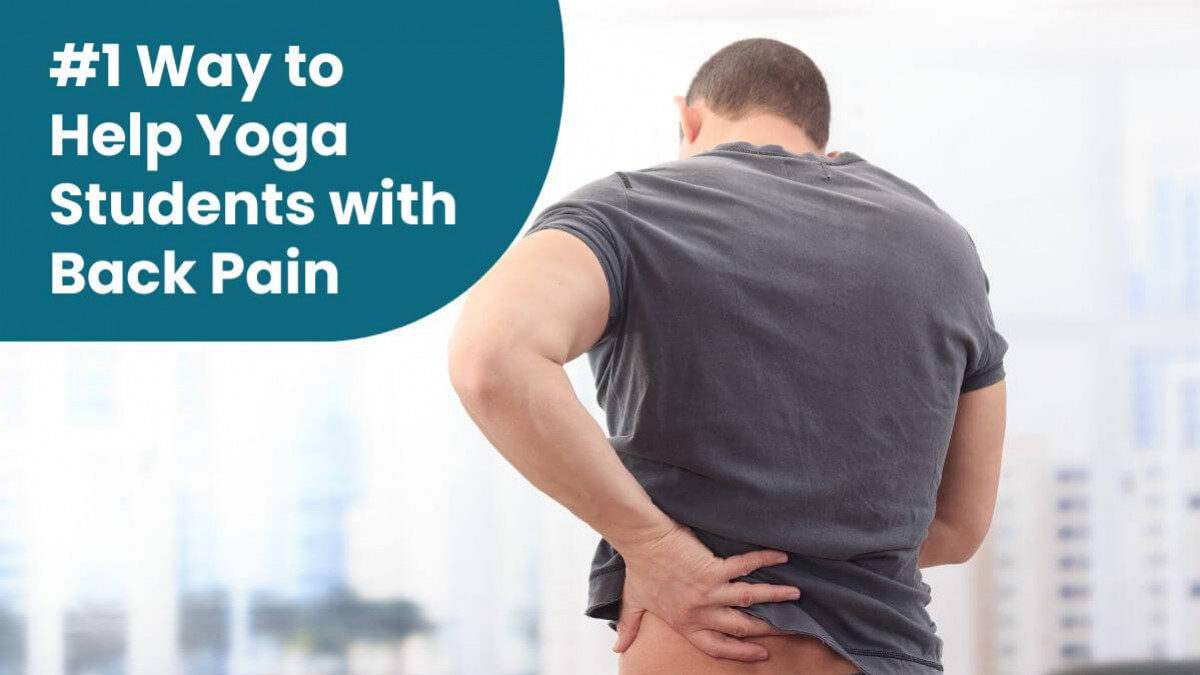#1 Way to Help Yoga Students With Back Pain

The answer will likely surprise you!
.
The number one way to help yoga students with back pain may not be what you think!
.
When I teach anatomy of the spine at yoga teacher trainings and workshops, I ask people to raise their hands if they have ever experienced back pain at any point. Everyone raises their hand.
.

If you teach yoga, you can guarantee someone has shown up to your class with back pain. And there’s a good chance you’ve had students ask you about it. How do you respond?
.
Understand this! Your response will directly impact someone’s experience of back pain!
.

.
Right now I am conjuring up memories of being a young physical therapist armed with knowledge about disc disease, joint dysfunction, special tests, differential diagnosis, exercise protocols, manual therapy skills, contraindications, and all the other things I learned in school. All of these things had the potential to be very effective in helping people heal and manage back pain. They still can be very effective today....as long as I utilize the #1 way to help people with back pain.
.
The most important thing to do when someone tells you they have pain is to….🥁🥁 🥁drum roll please……
Listen.
.
That’s it. Listen.
.
Listen to what they have to say.
.
And I don’t mean listen for the thing you think they will say; or for the thing you learned about in an article or a yoga workshop. I mean just listen.
.

.
This is certainly one of those simple, but not so easy tasks. And to be honest, the more you know about anatomy, the body, yoga and exercise, the harder it can be to just listen. As humans, our ego of knowledge can get in the way. And this will especially happen if you really want to help people.
.
What? How can your ego get in the way if you are just there to help?
.
Your ego pushes that part of you that wants to help. You ego will want that part of you to be armed with ways to help. Your ego does not want the part of you that wants to help to not be able to help. Not being able to help might mean failure. Your ego that will listen for the person's experience of back pain to match what you already know about back pain!
.
So just listen. Just hear what they have to say!
.
What do you do after you listen? Listen some more.
.
And if the yoga student with back pain is not saying much, simply say “Tell me more about your experience with back pain.”
.
If you truly listen, they will probably tell you exactly what they need and don’t need. And yes, they may be looking for you to help them find those things. If you haven’t listened, you won’t know what they need and won't be able to help!
.
I can’t tell you how many patients and yoga students have come to me for help, but actually told me what they need. When I ask them to just tell me more about their experience with pain, they often tell me what positions bother them, what feels good, what they want to do, what worries them, and what their goals are. Then my job is to simply direct them.
.
Okay, I can hear the questions and doubts: How will I know how to direct them? Well that all depends on your skill set and knowledge. As a yoga teacher, you are an expert in yoga postures. Start there!
.
Your ability to support yoga students with back pain and other injuries is so much more about your mindset than your their knowledge.
.

.
You already know that yoga has the power to heal. So by nature, you as a yoga teacher also have the power to heal.
.

.

In the Teach Yoga to Students with Injuries Course, there is a whole workshop that focuses on the yoga teachers mindset. There are four modules in total that will set you up to confidently work with students with pain and injuries.
.
#1 Mindset and Your Role:
Have the tools to truly believe in your own ability to listen to others and guide them on their path to health and wellbeing.
..
#2 Science of Healing and Pain:
Learn the physiological phases of healing and be able to use this knowledge to best guide your students who are recovering from injuries. Explore pain science and identify various factors that contribute to pain.
.
#3 Modifications & Systems:
Know various ways to modify yoga postures to meet the needs of students with injuries and pain. Trust yourself to know when and how to adapt what you teach for students.
.
#4 Mastery & Mentorship:
Mastery comes from putting knowledge and skill into practice!
The final module focuses on a case study. That's right, you will see exactly how to apply all of the information from the first three modules! You will meet Lucy who sustains and injury but wants to keep practicing yoga; and you will know how to confidently support her in the healing process.
.
Learn more and enroll in Teach Yoga to Students with Injuries
Categories: : Back Pain, Effective Teaching Techniques, Injuries & Yoga, Spine
 Trish Corley
Trish Corley 
